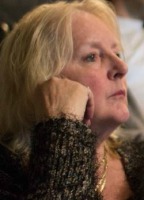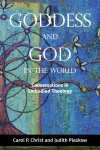“The pictures that line the halls speak volumes about the history of racism and sexism and they shape the future in powerful ways.”–Simon Timm
The author of these words recently posted a short video on Youtube entitled “Mirror Mirror on the Wall: The Legacies of Sexism and White Supremacy at Yale Divinity School.”* The video begins with a catchy little ditty with the words, “God is not a man, God is not a white man.” It tracks paintings and photographs of professors and other luminaries in the field of theology on the walls of the Yale Divinity School. By Timm’s count: 99 white males, 6 women, and 3 blacks. The single black woman is counted in both categories.
Among the white men are portraits of 49 YDS professors and administrators. An additional 50 photographs of theologians in the stairwell of the library are of white men. Although only a few of the images are identified, the women on the walls appear to include three retired white women professors and the first black woman to graduate from YDS. The black woman was added in 2015 following student protests along with the first black student (a male) to sit in on classes at YDS and the first black male student to graduate.
The video notes that YDS did not have a tenured woman professor until 1977 and did not have a tenured black professor until 2005. Apparently portraits of professors are added to the walls following retirement. It thus appears that no black professors have stayed long enough to retire at YDS.
I remember how I felt as a young white female graduate student at YDS in the late 1960s and early 1970s. Gold-framed oil paintings of white men in academic gowns glared down at me from every wall, reinforcing the common assumption that a woman was an anomaly in the hallowed halls in which I studied, took classes, ate lunch, and drank sherry with friends and teachers on Friday afternoons. Their omnipresence underscored the words of my professors and male student colleagues. “As a woman you will probably not finish your degree.” “Even if you do, I would give a job to a man with a family over you.” This sort of thing may not be voiced anymore, but jobs can still be defined as requiring expertise on white male theologians and white male theological traditions. Advisors can still advise students to focus their work within “the mainstream” if they want to be hired.
“Quite a few years after I graduated from Yale, I was in New Haven for a bat mitzvah and walked around downtown between the ceremony and the evening party. I found myself feeling spacey and slightly ill and wondered whether I was coming down with something. Then I realized that I was simply feeling what I had felt the entire time I was at Yale.”–Judith Plaskow in Goddess and God in the World


The toxic atmosphere at Yale both created and reinforced by the mirrors on the wall makes women and people of color intellectually doubt our right to be there, and it can penetrate into our blood and bones causing mental distress and physical illness.
“By continuing the near exclusive veneration of white men, many of whom perpetuated the institutionalized sexism and racism of the past, we reinforce the white male hegemony that has caused so much suffering to the rest of society.”–Simon Timm
Timm states that despite student protests asking for more images of women and minorities on the walls, nothing much has changed at Yale Divinity School. With tongue only partially in cheek I invite all of us who feel that our portraits or portraits of our favorite theologians should grace the stairwell of the YDS library to donate them–with appropriate epithets.
Maybe someone should start a fb page titled “Mirror on the Wall at Yale Divinity School” where theologians and theology students could upload photos of women theologians of all colors and men theologians of color with accompanying words. YDS administrators could be referred to the site. Just to be fair, we might also suggest adding photographs of unacknowledged coauthors such as Charlotte von Kirschbaum and Ursula Niebuhr.
*Thanks to Kate Ott for alerting me to Simon Timm’s video by posting it on Facebook.
Carol P. Christ is author or editor of eight books in Women and Religion and is one of the Foremothers of the Women’s Spirituality Movement. She leads the Goddess Pilgrimage to Crete in Spring and Fall: Early Bird Special until February 15. Follow Carol on Twitter @CarolP.Christ, Facebook Goddess Pilgrimage, and Facebook Carol P. Christ. Photo of Carol by Andrea Sarris.
 A Serpentine Path: Mysteries of the Goddess
A Serpentine Path: Mysteries of the Goddess will be published by Far Press in the spring of 2016. A journey from despair to the joy of life.
will be published by Far Press in the spring of 2016. A journey from despair to the joy of life.
Goddess and God in the World: Conversations in Embodied Theology with Judith Plaskow will be published by Fortress Press in June 2016. Exploring the connections of theology and autobiography and alternatives to the transcendent, omnipotent male God.


This reminds me of the Snow White fable, with its saying, “Mirror, mirror on the wall, who’s the fairest of them all?” Except the idea of fairness changes its meaning here to equal rights. And I guess that’s the point. But interesting that our goal too of “fairness” is not our physical beauty but our liberation and equality as women.
LikeLike
I love this reinterpretation of Snow White’s famous lines. Thanks, Sarah.
LikeLike
I immediately thought of Alice Walker’s wonderful book, THE COLOR PURPLE, and the following quote in particular:
“Man corrupt everything, say Shug. He on your box of grits, in your head, and all over the radio. He try to make you think he everywhere. Soon as you think he everywhere, you think he God. But he ain’t. Whenever you trying to pray, and man plop himself on the other end of it, tell him to git lost, say Shug. Conjure up the flowers, wind, water, a big rock.”
Thank you for your post today, reminding us that we’ve still a long, long way to go.
LikeLike
Exactly!
LikeLike
The English department at Southern Illinois University that graduated me with my Ph.D. wasn’t quite as sexist or racist as the YDS, but it sure did suffer from what I called terminal macho. But the two top Ph.D.graduates in 1076 were me and another woman, both of us with straight A’s. The old boys had never seen such a thing before. Hah!
LikeLike
1076, you are old! Seriously, in those days chances are the women were smarter, as we would not have been encouraged to go on for a PHD had we not been “at the top of the class.” What really upsets me is that so little has changed. A few feminists got ahead, but not enough of us!
LikeLike
As regards “God is not a man.” I wonder if anyone has ever tracked back how far that concept of gods and goddesses goes. Perhaps the Venus figurines might be considered the beginning, but how far back do they go? The famous Venus of Willendorf is estimated at 28,000-24,000 BCE. But there are female figurines much earlier too. In any case, it’s the concept of goddess not god, that seems to be the progenitor of such beliefs.
LikeLike
Jane Goodall suggests that chimpanzees may feel awe and wonder.
LikeLike
I would guess that the same video could be made at Harvard Divinity School changing only the names. Carol is right– the longer this persists, the worse it is. Many people assume far more change has happened than is actually the case.
LikeLike
I do like the video, but I am wondering whether there is any other art hanging on the YDS aside from portraiture? We are connected to all things, not just people. I wouldn’t mind if trees were over-represented.
LikeLike
Good point, but then Protestant theology never was about the spirit in nature, was it?
I am not sure that there were any other paintings of any kind. Which if I am right makes the idolatry of the white man all the worse.
LikeLike
Thanks, Carol, for this reminder of how far we need to go in order to overcome the entrenched misogyny and racism of our so-called “academies.” Your post reminds me of Emily Culpepper’s “Period Piece,” her Master of Divinity thesis. In response to the same types of frowning male faces covering the walls of Harvard Divinity School, Culpepper positioned a camera beneath a glass table and filmed herself menstruating onto it. I have a Unitarian Universalist minister friend who calls this kind of in-your-face response to sexism, “to culpepper.” May we culpepper more and more until our feminine reality becomes recognized and validated by our culture.
LikeLike
Sharing this post with a friend who is contemplating graduate work at Yale in Women’s and African American studies! Thanks!
LikeLike
Yes, we have come a long way–my students and I were reading Mary Wollstonecraft today–but it never seems to really end either in academia or elsewhere. My question is what can we do to facilitate a kinder, egalitarian world?
LikeLike
Thank you so much for drawing attention to the video! I said the issue should have been addressed decades ago and it’s great to hear from those who have been fighting for it for that long! Here is my op-ed that was published today in the Daily News:
http://yaledailynews.com/blog/2016/02/10/timm-inequality-on-the-yds-walls/
LikeLike
Hi Simon, thanks for your work on this subject. Have you seen the Ordain Women fb and website. Maybe you could start something analogous for Women on the Walls at YDS. Good luck!!! Just watched Spotlight and was again a-mazed about the lengths those holding spiritual power will go to maintain it.
LikeLike
Is it possible that most women just see the ridiculousness of religion and chose instead to study something meaningful?
LikeLike